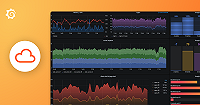Receive profiles from Pyroscope SDKs
The pyroscope.receive_http component in Alloy receives profiles from applications instrumented with Pyroscope SDKs. This approach provides several benefits:
- Lower latency by sending profiles to a local Alloy instance instead of over internet
- Separation of infrastructure concerns (auth, routing) from application code
- Centralized management of authentication and metadata enrichment
For more information about this component, refer to the pyroscope.receive_http component documentation.
Note
The
pyroscope.receive_httpcomponent is currently in public preview. To use this component, set the--stability.levelflag topublic-preview. For more information about Alloy’s run usage, refer to the run command documentation documentation.
To set up profile receiving, you need to:
- Configure Alloy components
- Configure your application’s SDK
- Start Alloy
Configure Alloy components
The configuration requires at least two components:
pyroscope.receive_httpto receive profiles via HTTPpyroscope.writeto forward profiles to Pyroscope
Here’s a basic configuration that sets up a simple profile collection pipeline. It creates a receiver to collect profiles from your applications and forwards them through a writer component to send them to the Pyroscope backend:
// Receives profiles over HTTP
pyroscope.receive_http "default" {
http {
listen_address = "0.0.0.0"
listen_port = 9999
}
forward_to = [pyroscope.write.backend.receiver]
}
// Forwards profiles to Pyroscope
pyroscope.write "backend" {
endpoint {
url = "http://pyroscope:4040"
}
}Configure application SDK
Update your application’s SDK configuration to point to Alloy’s receive endpoint instead of Pyroscope directly. For example, in Go:
config := pyroscope.Config{
ApplicationName: "my.service.cpu",
ServerAddress: "http://localhost:9999", // Alloy's receive endpoint
}Check your specific language SDK documentation for the exact configuration options.
Examples
The examples in this section provide samples you can use as a starting point for your own configurations.
Explore the example in the Pyroscope GitHub repository to learn how to configure Grafana Alloy to receive profiles from a Golang application instrumented with Pyroscope.
Basic receiving setup
This example shows a basic setup receiving profiles on port 9090 and forwarding them to a local Pyroscope instance:
pyroscope.receive_http "default" {
http {
listen_address = "0.0.0.0"
listen_port = 9090
}
forward_to = [pyroscope.write.production.receiver]
}
pyroscope.write "production" {
endpoint {
url = "http://localhost:4040"
}
}Authentication
To send profiles to an authenticated Pyroscope endpoint:
pyroscope.write "production" {
endpoint {
url = "http://pyroscope:4040"
basic_auth {
username = env("PYROSCOPE_USERNAME")
password = env("PYROSCOPE_PASSWORD")
}
}
}Adding external labels
External labels are added to all profiles forwarded through the write component. This is useful for adding infrastructure metadata:
pyroscope.receive_http "default" {
http {
listen_address = "0.0.0.0"
listen_port = 9999
}
forward_to = [pyroscope.write.backend.receiver]
}
pyroscope.write "backend" {
endpoint {
url = "http://pyroscope:4040"
}
external_labels = {
"env" = "production",
"region" = "us-west-1",
"instance" = env("HOSTNAME"),
"cluster" = "main",
}
}Multiple destinations
Forward received profiles to multiple destinations - useful for testing or migration scenarios:
pyroscope.receive_http "default" {
http {
listen_address = "0.0.0.0"
listen_port = 9999
}
forward_to = [pyroscope.write.staging.receiver, pyroscope.write.production.receiver]
}
// Send profiles to staging
pyroscope.write "staging" {
endpoint {
url = "http://pyroscope-staging:4040"
}
external_labels = {
"env" = "staging",
}
}
// Send profiles to production
pyroscope.write "production" {
endpoint {
url = "http://pyroscope-production:4041"
}
external_labels = {
"env" = "production",
}
}Note
This configuration will duplicate the received profiles and send a copy to each configured
pyroscope.writecomponent.
Another approach is to configure multiple receivers with multiple destinations:
pyroscope.receive_http "staging" {
http {
listen_address = "0.0.0.0"
listen_port = 9998
}
forward_to = [pyroscope.write.staging.receiver]
}
pyroscope.receive_http "production" {
http {
listen_address = "0.0.0.0"
listen_port = 9999
}
forward_to = [pyroscope.write.production.receiver]
}
// Send profiles to staging
pyroscope.write "staging" {
endpoint {
url = "http://pyroscope-staging:4040"
}
external_labels = {
"env" = "staging",
}
}
// Send profiles to production
pyroscope.write "production" {
endpoint {
url = "http://pyroscope-production:4041"
}
external_labels = {
"env" = "production",
}
}For more information about component configuration options, refer to:
- pyroscope.receive_http documentation
- pyroscope.write documentation


